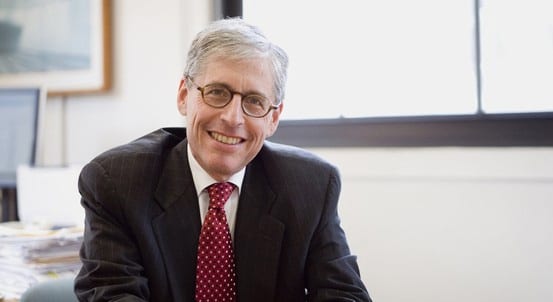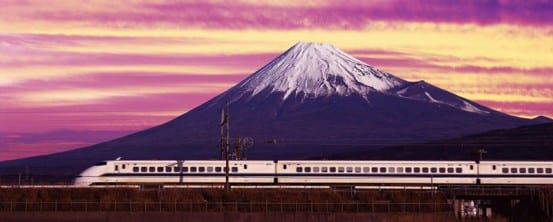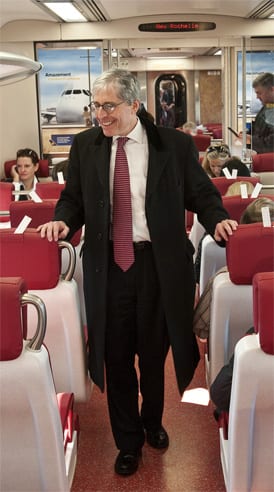On Friday I had the pleasure of speaking with Howard Permut, President of Metro-North Railroad. Though there are many things one could ask the president of the railroad, admittedly I was interested in his unique perspective regarding the history of Metro-North. Mr. Permut has been with Metro-North since its inception in 1983, and prior to his position as president, served as as the Senior Vice President of Planning. Though most commuters today are likely unaware of it, Metro-North has improved in leaps and bounds over the years, starting out from the shambles left by Penn Central that were grudgingly operated by ConRail. So he’s definitely seen this railroad at its worst – and as its best.

Photograph from this site. Unfortunately it totally slipped my mind to try and get a photo. Yes, I’m a dope. Second photograph below of Howard Permut is from the MTA.
Anyways, on to the good stuff. While I debated using the conversation to write an article, I felt that the words would be most interesting in the interview format they were spoken. And thus, here is a complete transcript of the conversation I had with the president of Metro-North on Friday!
Metro-North has come a long way since its formation from ConRail. Do you have any strong memories from those early days, and is there any particular accomplishment since then you are most proud of?
I’ve been at Metro-North since we started. When we took over we were the worst railroad in North America, we’ve now moved to be the best railroad in North America. In fact, last year we won the award, called the Brunel Award, which is for the best design of any railroad in the world – and Metro-North won that, beating out competitors from Japan and Europe. It is something we’re very proud of, because it reflects all the progress we’ve made.
My memories from the beginning were that nothing worked. If you go back to 1983 the trains were rarely ever on time, the heat was always working in the summer, and the air conditioning in the winter, Grand Central was a homeless shelter – we had 900 people living in Grand Central when we took over – there was nothing good about Metro-North.
One memory I always have is on the Harlem Line, taking a trip up in the old coaches – and they came from any place in the world that ConRail could find them. Literally the whole trip to Pleasantville, in a cold car in October, I was holding up the side of the wainscoting, the side of the train, because I thought it was going to fall on me.
As for what I’m most proud of, I’m incredibly proud of how the organization has changed itself from the worst to the best. We’ve made huge achievements – our on-time performance is the best in the country, we have a great safety record, we’ve become significantly more efficient, and we’ve doubled the ridership to become the biggest railroad in North America. Those are really amazing achievements.
Do you recall any of the planning that went into the decision to “rebrand” the railroad as Metro-North and not Metro North Commuter Railroad, and in what ways would you hope to attract more non-commuters in the future?
I remember very well because I was integrally a part of that, and we made the decision, in the late 1980’s, if I recall correctly, that Metro-North – we were much more than just a commuter railroad. We were carrying a lot of discretionary riders, a lot of people who are going halfway up and down the line, and that it was important that we were known as Metro-North Railroad than Metro-North Commuter Railroad – so it was a very specific decision.
You asked about discretionary riders – one of the most important things, and one of the things I always emphasize, is we have customers, not riders, something Peter Stangl our president changed the vernacular for. Everybody has a choice to ride or not ride Metro-North, and it’s our goal to give everybody and provide significant value that people want to take Metro-North. Our ridership has doubled, which is a fantastic achievement over the past 30 years. A lot of that has been driven not by commuters at all, but by discretionary riders – weekend riders, by off-peak, by evening, by intermediate riders. We continue to focus on that, and we’ve done numerous different things over the years to increase the ridership.
Going forward I’m really excited that we’re going to be adding all this off-peak and weekend service, trains will be running every half hour. That will be an enormous improvement for our riders, they can now know that they can come into the city, for example, and not have to worry about missing their train. Because if you miss it there’s another train in a half hour, and you’re in Grand Central, which is the center of New York anyway. So you’ve lost nothing, and it frees up people from worrying about that and I think that will greatly increase our weekend and off-peak ridership.
When the Harlem Line extension was being planned, was Millerton ever on the table, or was the main focus always Wassaic?
Again, I was involved with that because I was head of planning then. We focused, and our goal was to get as far north as we could while implementing the project. We wanted to go far north for two reasons, we needed a location for a railyard, we didn’t have sufficient room in Southeast, and we wanted as far north so we could attract as many customers as possible. The best site to do that was Wassaic. If I remember correctly, the rail trail was already in existence to Millerton, so we would have had a huge obstacle. How do you de-map a rail trail? There would have been significant opposition. I believe there was opposition in Millerton itself for train service.
The question became to us, we think if you want to get this done, we think we can make it to Wassaic and get that implemented. If we try to go further north, which would have been in an ideal world nice, we believe we would have had nothing. And so this was a case of getting 80%, and getting it done. And once we got through all the environmental reviews we were able to build the line, and I guess it has been running for ten, almost fifteen years now.
Do you have a favorite Metro-North station?
Truthfully I do, and it’s Grand Central. Where else? It is the center of New York, it’s an amazing place.
Are there any other transit systems you admire?
First of all I admire what New York City subways does day in and day out, carrying that number, millions of people. I think that there are other properties within the United States who do certain things very well. Metro-North is particularly focused on partnership with JR East in Japan, and I certainly admire many things that they do. The volumes of people that they carry are phenomenal, their reliability is phenomenal. They make money – which is unlike any transit system in the United States – in part that is because they are allowed to own the real estate, unlike Metro-North where almost all the real estate has been given away by the predecessor railroads – so they are capturing the value created by the railroad. They, in particular, are a group that we’ve probably met with four or five times and exchanged ideas, and continue to do so.

JR (Japan Railways) East shinkansen, or as it is more commonly known in the US, bullet train.
If you could tell every Metro-North rider one thing, what would it be?
I would say that I would hope that people continue to recognize the value of Metro-North, that they continue to ride Metro-North, they continue to encourage their friends and family to ride Metro-North, and that if they see things that they think we should make improvements on that they should let us know. We take very seriously all the letters we get, I personally read every single letter that is sent to me, and if they have really good ideas we will follow up on them. We’ve gotten over the years many good ideas from people, many issues have been raised, and we respond to them. Again, it would be use the train, and if you have any ideas or suggestions, let us know, and we’ll take a look at them and see if it makes sense, and if we can do them we will.



I think it’s worth noting that the Brunel Awards are named for Isambard Kingdom Brunel, the famed builder of England’s Great Western Railway. He made his most recent appearance (portrayed by Kenneth Branagh) at the opening ceremonies of the London Olympics (with many Americans mistaking him for Abraham Lincoln).
That and the appearance by Tim Berners-Lee were certainly my favorite parts of the opening ceremony!
Nicely done!
It’s a shame there’s NIMBYism for restoring the RR up to
Millerton(Z). An active RR is better than a trail, and so it goes….
Note: Milerton might have been a streach to add to MNR
territory however.
“An active RR is better than a trail . . . ”
As much as I enjoy biking on the rail-trail that runs right past my house, and as much as I (and thousands of others) enjoy the Walkway Over the Hudson, I have to agree. I seem to recall that, years ago, one of the advantages touted for the conversion to rail-trails was that the right-of-way would be preserved in the event that rail service was once again deemed feasible. I guess that’s not gonna happen.
As far as Poughkeepsie bridge is concerned,the fire back in
the Penn Central “era”” killed” off any chance of bringing that
route back. I understand the trail idea was an attempt to
“bank” the ROW for return to service in the future.
What remains of the Maybrook line is “railbanked” for now
by MNR.
Realistically, I think there would be a lot of opposition of people that enjoy the rail trails. So in thought you’re saving the ROW, but in practice, not sure if it’d ever happen.
I can’t really hate rail trails, though. At least it somewhat preserves the history that was there. Hypothetically speaking, had the Harlem Valley Rail Trail not been there, I don’t think the they would have extended that far anyway. There was enough opposition in the town, and definitely no room for a railyard, which was another key point.
If memory serves,just north of Millerton was the crossing
and interchange with the Central New England RR,while
a minor interchange point for NYCentral ,there was
enough land to build at least the connecting trackage
between the 2 RR’s,so a small 2-3 track yard was possible.
Now there must be some sort of single family housing
on the site.
Very cool that you got the opportunity to do this interview, and you packed a lot in to a short time! Nicely done :)
Great questions and interview – excellent perspective into Metro-North’s history and legacy!
I have a set of signal prints titled ” N Y C RR– signal dept==Millerton Circuits — C N E R R & N Y C R R crossing —24 April 1935 ”
Another set of signal prints has a dotted track-line with the dots IDed as follows—[No White Plains 239 ] –[ Valhalla 254 ]—[Kensico Cemetary 263}– [ Mt Pleasant 272 ]—[ Hawthorne 282 ]–[ Thornewood 298 ] ———[ Pleasantville 305 ]–[Chappaqua 323 ]—[Mt Kisco 366 ]–[Bedford Hills 391 ]—[Katonah 410 ]—- Goldens Bridge 391 ] ( a spur at Goldens bridge to Lincolndale and Lake Mahopac )— [ Purdys 461 ] — [Croton Falls 477 ]—[Brewster 519 ]—[Putnam Junction 523 ]–[Dykemans 547 ]— [ Ice Pond 562 ]–[Towners 570 ]—[Patterson 602 ] –[ Pawling 637 ] —{Wingdale 697]–[ Dover Furnace 724]—[ Dover Plains 766 ]—[Wassaic 813]–[Amenia 846 ]–[Sharon Station 877 ]—[ Coleman’s 890 ]—[Millerton 927 ]—[Mt Riga 958 ] —[ Boston Corners 997 ]—[ Copake Falls 1048 ]—[Hillsdale 1088 ]—[ Carryville 1116 ]—[Martindale 1154 ]—[ Phiolmont 1188 ]–[ Ghent 1248]—[ Chatam 1275 ]
The Harlem Lines “neighboor” , the Putnam Div. , once featured ( for it’s time ) , an engineering marvel in the form of the Eastview Trestle”. Splendid research on this notable structure here————-
http://archivesleuth.wordpress.com/category/railroads/
JDR purchased the entire hamlet of Eastview when he paid to re-locate the line of the Putnam away from the front of his estate.